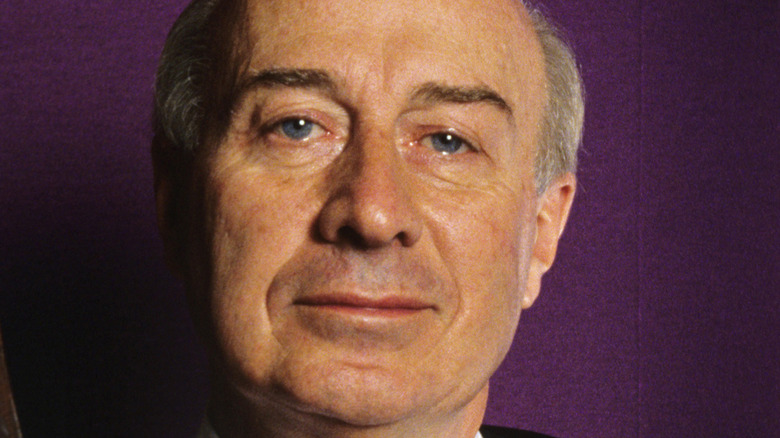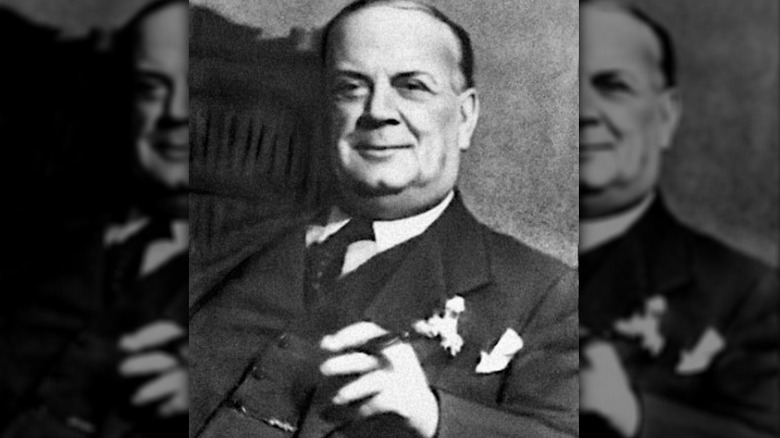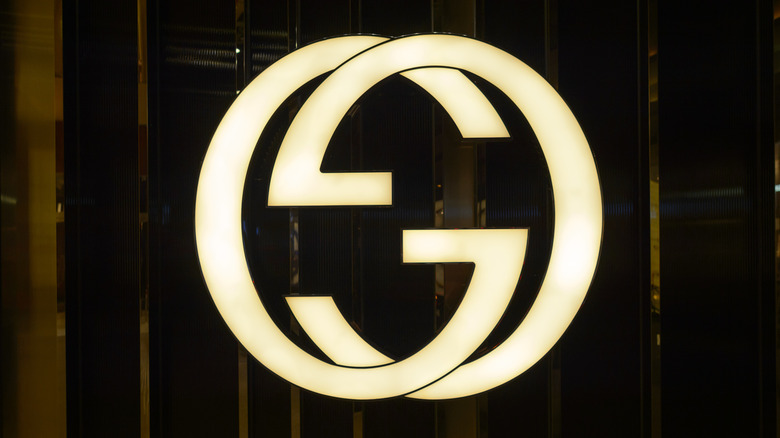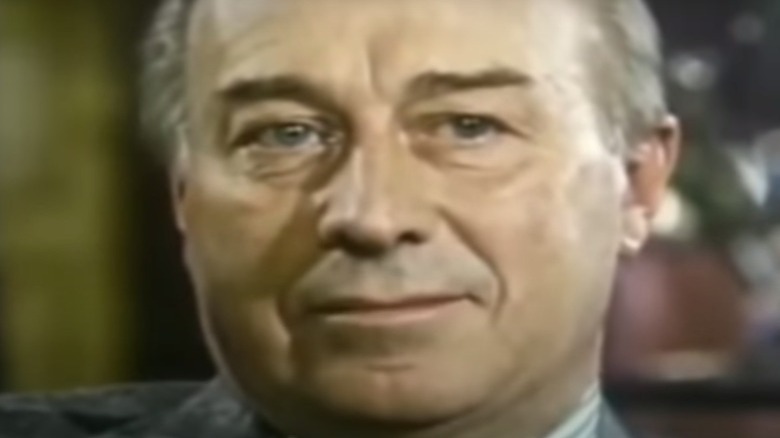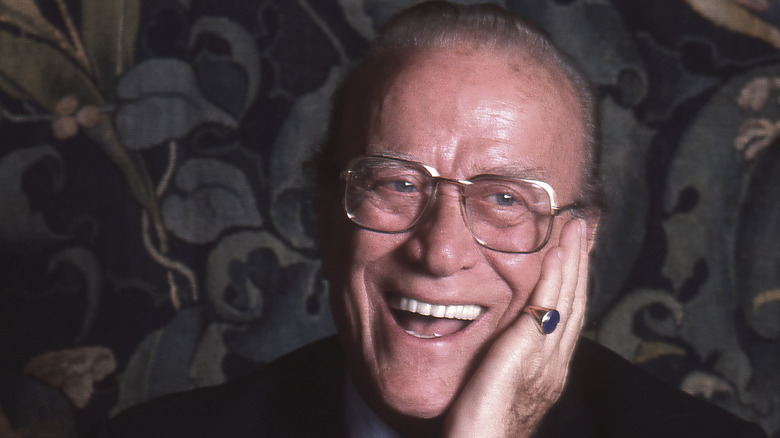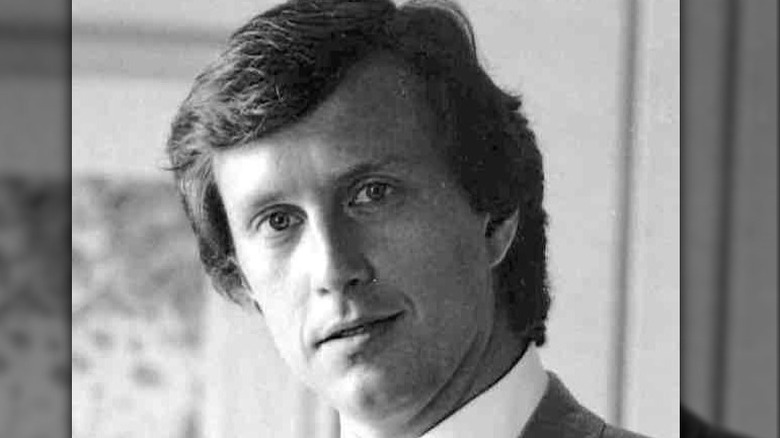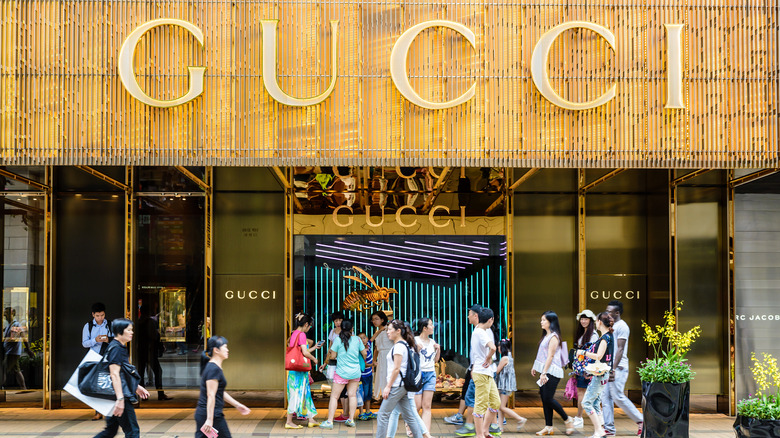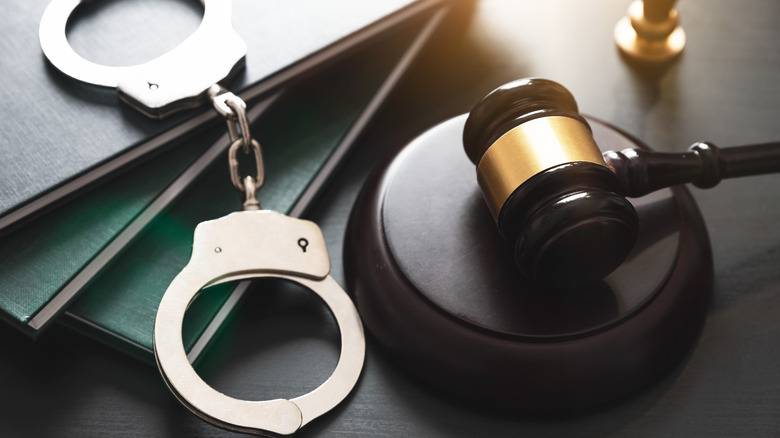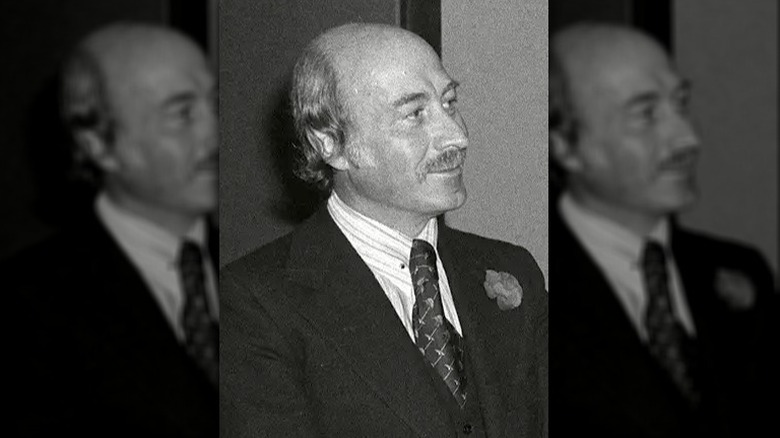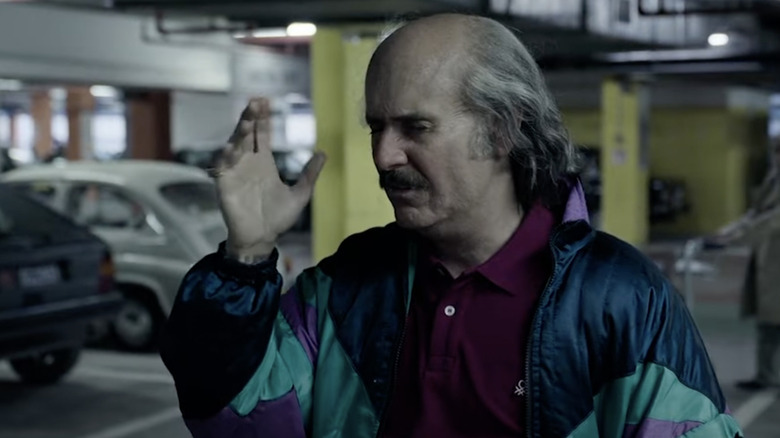The Untold Truth Of Paolo Gucci
The origin tale of the storied global luxury brand, Gucci, is charming, if nothing else. At the end of the 19th century, a young man by the name of Guccio Gucci left his home in Florence, Italy and set sail to find work in England to make a better life for himself. Guccio, still a teenager at the time, found work as a dishwasher, a bellboy, and a lift operator at the luxurious London Savoy Hotel. He was instantly mesmerized by the style and fashion of the rich and famous guests of Europe's premier hotel, per the Independent. Guccio took special note of the suitcases and travel bags of the wealthy travelers, marveling at the quality of the leather and how it was perfectly stitched.
A few years later, Guccio returned to Florence with an idea to build his own leather goods company — a saddlery — named Gucci. By 1921, with his romantic memories of his time at the Savoy on his mind, he retooled his company to make a broader range of artisanal goods for wealthy clients, including luggage, wallets, and other accessories, according to InStyle. Within a couple decades, Guccio and his sons — especially Aldo — turned Gucci into a symbol of craftsmanship, fine taste, and status around the world. But after Guccio's death in 1953, and a third generation entering the business, the family-run empire would come crashing down in a battle for control of the company, which included an ongoing war between Aldo and his son, Paolo Gucci.
Paolo was born into the family business
Paolo Gucci was born on March 29, 1931, one of three sons of Aldo Gucci and Olwen Price. When a new child in the family was born, Guccio (pictured above) would say, according to Sara Gay Forden's book, "The House of Gucci: A True Story of Madness, Glamour, and Greed," "Let him smell a piece of leather, for it is the smell of his future." That's because as far as Guccio was concerned, his grandchildren were born into the Gucci family business and would fill important positions in the company one day. As teenagers, Aldo's sons were encouraged to work in the shop by Guccio. They would wrap packages and deliver parcels as Aldo had once done. For Guccio, it was the only way to learn the family business: Start from the bottom and work your way up.
However, just as Guccio was a domineering father to Aldo, Aldo was extremely hard on his sons, per the Los Angeles Times. And for his freethinking ways, Paolo often bore the brunt of it. Once, as punishment for a nominal error in judgment, Aldo gave Paolo's dog away, according to Forden's book, leaving Paolo inconsolable for a week. Still, Paolo stuck with the family business and got out from under the thumb of his father by working for his Uncle Vasco in the factory, where they both learned Paolo had a talent for design, refining several of his ideas for a full line of Gucci offerings.
Paolo was crucial to Gucci's expansion
Although Paolo Gucci is often depicted as the dolt of the family, Gucci likely would not have become the fashion powerhouse it is today without his contributions as a designer at a critical point in the company's history. While Aldo first took Gucci international in 1953 by opening a store in New York, Paolo was most happy in Florence working on his designs. He refined the iconic "double-G" logo his father first iterated, solidified red, green, and black as Gucci's signature color palette, and looked forward to what might come next in Gucci design. According to Bustle, by the 1960s, Paolo had become Gucci's chief designer.
As Aldo pressed ahead by opening more stores in the U.S. and eventually around the world, Paolo saw that as an opportunity to expand the Gucci products beyond bags and leather accessories. In 1972, a store solely dedicated to a new line of Gucci clothing opened at 699 Fifth Avenue in New York, while the store at 689 Fifth Avenue remained focused on luggage, bags, shoes, and accessories. "It was my son Paolo's idea," Aldo told The New York Times, when the company announced the plans. "He does most of our designing. ... I said, 'Why not?' I will enjoy seeing a charming lady dressed in Gucci from head to toe." Before long, dresses, silk scarves, blouses, men's shirts and ties, and more eventually snowballed into 4,000 other products, with Paolo's design on 80% of them, per The Times.
Paolo became restless at Gucci
By the late 1970s, Paolo had risen to vice president of Gucci after years as the company's chief designer. But before long, Paolo began to think his promotion was a strategy to keep him out of the way of his father and uncle. "I wanted to expand," Paolo told People years later, "to bring in other financial backers and make the business run on more modern lines. But the Guccis have medieval concepts of business. So I became the black sheep." Paolo grew increasingly frustrated that his vision for the company wasn't being taken seriously, so he tried to secretly launch his own fashion line without consulting his father or uncle. The unilateral move infuriated the family elders. The board, headed by his father, fired him immediately and sued him for infringing on Gucci trademarks. Per ABC News, they also sent out a warning to all suppliers: Work with Paolo, say goodbye to Gucci business.
For his part, Paolo filed a series of countersuits against the company and his father for lost income on his semi-existent company and for the freedom to put his designs on the market using his own name. The lawsuits became their own kind of family soap opera playing out in public and reached a new level of absurdity when Aldo began footing the bill for Paolo's lawsuits against him. "Yes, every time Paolo ran out of money to pay his lawyer, Aldo would pay," a family friend told Vanity Fair.
Paolo ratted his father out to the IRS
In 1982, in the middle of numerous lawsuits, an already tense family situation turned violent during a board meeting in Florence, when Paolo claimed he was assaulted and bloodied after informing his family that he intended to record the proceedings. Within days, Paolo piled on another lawsuit in New York, seeking $13 million in a claim that he was beaten by his two brothers and cousin, Maurizio, who were instigated by his father, Aldo (above), per Bustle. Aldo brushed aside the accusations, saying (via People) that Paolo "likes to exaggerate." Although he didn't deny the meeting had become violent, he said: "[W]ho has never given a slap to a reckless son?"
Through it all, Paolo maintained his 3.3% stake in the company, which gave him an income and the ability to be a headache for the rest of the Gucci clan. After a few more years of lawsuits and undermining each other, Paolo decided to exact revenge against his father by ratting him out to the IRS for tax evasion, per Vulture. A government investigation found that millions of dollars in personal income had not been reported to the IRS. Aldo, in his 80s, was sentenced in 1986 to a year and a day in prison for his failure to pay $7 million in personal income tax. He cried in court, saying (via The New York Times), "I forgive [Paolo], and I forgive anyone who wanted me to be here today."
Paolo is double-crossed once again
When Aldo and his brother Rodolfo became equal owners of Gucci after the death of their brother Vasco 1974, Aldo took 10% of his half and split it equally among Paolo and his two brothers, per South China Morning Post. Aldo meant it to be an incentive to his sons to grow the business for their own personal gain. His choice also made Rodolfo the majority stakeholder with 50%. But by Aldo's calculations, that wasn't a problem as long as Rodolfo was alive. But that all changed when Rodolfo died in 1983 and his only son, Maurizio (pictured above), who had a different vision than Aldo, took majority owner status with a 50% stake in the company.
In 1985, Maurizio made a pact with Paolo. Together, they would boot Aldo as chairman of Gucci and vote Maurizio into the position. Paolo, who was still angry with his father over their many lawsuits, was happy to make a pact with his cousin. For Paolo's cooperation, Maurizio promised his support for the new direction in design that Paolo wanted all along under his PG label. Paolo moved forward with his line, finally able to show his work. But, in another act of betrayal, Maurizio double-crossed Paolo by sending police to his March 1986 launch in Rome, per Slate. The police shut down the fashion show and took possession of the collection, citing breach of contract.
Paolo sells out of the Gucci family business
While Aldo was serving his prison sentence, Maurizio was running Gucci from the boardroom and on a daily basis. He soon realized the only way he could have full, unfettered control of every aspect of the company was if he could find an investor to buy out the stakes his family members still had in the company. He turned to Nemir Kirdar and his Bahrain-based Investcorp. Paolo was the first to cave. He sold his stake in the business for more than $40 million, according to the Independent, figuring he could use the funds to finally move his own fashion house forward.
Aldo was devastated to learn what Paolo had done once he was released from prison. He was the last holdout, finally selling his shares in 1989. Eventually, Maurizio overspent and mismanaged the company, forcing him to sell his shares to Investcorp and marking the end of any Gucci ownership in the company. "You cannot blame any one person for what happened," an Investcorp executive told The Observer. "The younger members of the family had their own ideas on what was best. It was a classic third generation problem."
Paolo mismanaged money his whole life
Throughout his life, Paolo Gucci struggled to manage his finances, despite being born into affluence, thanks to the global brand his family built. Paolo's life careened between extreme wealth and total bankruptcy. At times, he maintained lavish homes on multiple continents, and other times he seemed incapable of caring for himself. When Paolo sold his part of the Gucci empire to Investcorp, it was the beginning of the end of Gucci as a family-run business — and the end of any sort of Gucci cash flow for Paolo. He meant the massive influx of money to fund his own fashion house, but he quickly burned through it. As his New York Times obituary put it, "Mr. Gucci ran through the money twice, once when he had it and once when he didn't. He declared bankruptcy in 1993, claiming $90 million in debts."
Soon after, the depths of his embarrassing financial woes became public. In 1994, Paolo was tossed in a Bronx jail for five weeks for failing to pay about $500,000 in child support for his 10-year-old daughter and alimony to his estranged second wife of 14 years, Jennifer Garwood, per the Independent. That same year, more than 100 Arabian horses were found starved and nearly dead on two upstate New York farms owned by Paolo Gucci, the Associated Press reported at the time. Gucci was reportedly unable to pay for feed for the horses, and several of them died due to malnourishment.
Paolo Gucci dies at 64
In the fall of 1995, Paolo Gucci left his home in Sussex, England to return to Florence to see his friends and family, as he regularly did. On that trip, he visited his first wife, Yvonne, and his daughter, Patrizia. In her book, "Gucci: A Successful Dynasty As Recounted by a Real Gucci," Patrizia recalled that during the last phone call between her parents, her mother said she had picked up a strange tone from Paolo. Something was not right. And when Paolo showed up to their home in Florence, Patrizia saw there was a visible problem. "I, too, was shocked when I first saw him — he had lost a lot of weight and was quite pale," she wrote.
Yvonne immediately made a number of appointments at the hospital, setting up doctor consultations and scheduling tests. It was a grim diagnosis of final stage hepatitis C. His only hope was to go back to London for a liver transplant. Patrizia accompanied him on the trip. As she boarded the plane to return to Florence, she recalled in her book, "I watched his hand move as if he wanted to brush away the life that was slipping away from him — the life he would no longer live." Just a couple of weeks later, Paolo landed in the intensive care unit at King's Cross Hospital, per the AP. October 10, 1995, Paolo Gucci died in London from the effects of chronic hepatitis. He was 64.
Jared Leto's Paolo accent in 'House of Gucci' insulted the Gucci family
In popular culture, Paolo Gucci became known to the world with the 2021 release of Ridley Scott's film "House of Gucci," with Jared Leto playing the part of Paolo. The dramatic Italian fashion family soap opera focuses on the tumultuous relationship between Gucci heir Maurizio Gucci (Adam Driver) and his wife, Patrizia Reggiani (Lady Gaga). The film, which was based on Sara Gay Forden's 2001 book "The House of Gucci" covers the two-and-a-half decades of the couple's history, from their first chance encounter to Reggiani hiring an assassin to kill Maurizio. Throughout the film, Scott highlights an extended family that spent decades manipulating, undermining, and cajoling one another for power within and outside the Gucci company, much of which found Paolo front and center.
Critics and audiences were not on the same page when it came to rating the film, per Rotten Tomatoes, and the Gucci family was decidedly unhappy about how they were portrayed by Scott. For his part (via the New York Post), Leto was widely panned for presenting Paolo Gucci with a comical accent closer to Mario Brothers than an executive for one of Italy's finest brands. "We are truly disappointed. I speak on behalf of the family,” Patrizia Gucci, Paolo's daughter, told The Associated Press. "They are stealing the identity of a family to make a profit, to increase the income of the Hollywood system. ... Our family has an identity, privacy."
